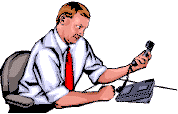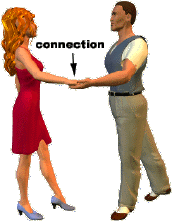Leading and Following in Open Positions
Communication and Connection
The skills involved in leading and following center around principles
of communication. The best leaders are those who communicate their
intentions, while the best followers are those who respond well to
the leader's intentions. This is facilitated when both leader and
follower do their part to maintain open lines of communication.

At some point or another, we've all been frustrated by a poor phone connection. Nothing makes having a conversation more difficult or miserable than when you're trying to talk over static, interference, and other general interference resulting from a poor connection. It sure makes you appreciate the times when you do have a clear signal!
The lead-and-follow process can be likened to a telephone conversation: The better your connection, the easier it is to have a conversation. So in the coming sections, we will explore some ways to improve your connection, so that you can lead and follow with a solid "4-bar" connection, rather than two tin cans and a string!
What is a Connection?
A connection is any physical point of contact between two partners in a dance position.

According to this definition, a connection can be any point where you actually
touch your partner. While this is technically correct, it's not entirely
accurate. Normally, when we think of a connection, we think of a point through
which you lead or follow your partner. So it's not enough to simply touch your
partner or hold their hand. In order to lead or follow, your connections must do
more. For example:
-
A connection must have TONE.
In order to function properly as a transmitter of signals, the connected body
parts should maintain a certain degree of muscle tone. If the connection is
limp or weak, the lead-and-follow signals will not run through it.
-
A connection must be ACTIVE.
A working connection is a living, breathing thing. It must be alive, responsive
to the situation, and ready to transmit and receive signals. In addition to
being toned, it must also be flexible, and ready to change to accommodate any
situation.
-
A connection must be MUTUAL.
It takes two to have a conversation. Both parties must do their part to maintain
the connection. When one person falls short, the conversation dies, no matter
how much the other may try to compensate.


